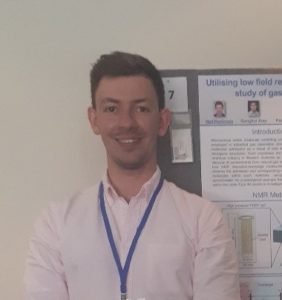Functional porous materials underpin a vast range of critical chemical processes, with prominent examples including water purification, building material formulation, fuel storage, pollution abatement, and the energy-efficient production of useful materials from both natural and renewable resources. The underlying chemical and physical processes associated with such applications are a result of the interactions of these porous structures with fluids (gases or liquids), typically via their encapsulation, surface-adhesion, and/or chemical reaction. The efficacy of the materials employed within such applications (such as porous metal oxides, zeolites and metal-organic frameworks) is a direct consequence of their inherently large surface-to-volume ratios, which ensure that interfacial interactions dominate the behaviour of imbibed chemicals.
Despite the ubiquity and importance of porous media across the spectrum of chemical sciences, our understanding of many of the basic properties of fluids confined within these materials remains very limited. Indeed, characterising interfacial phenomena occurring at the highly inaccessible solid surfaces contained within porous structures is a significant analytical challenge, requiring state-of-the-art techniques with the ability to discriminate between molecules interacting with the interface of interest and the surrounding solid and fluid components. NMR relaxation methods have recently emerged as potential route to such information. Unlike NMR spectroscopy, which provides structure-dependent NMR frequency data, relaxation methods depend on the time-domain behaviour of the acquired NMR signal. This relaxation data is sensitive to molecular dynamics, and for fluids confined within porous structures has the potential to provide insight into a plethora of phenomena, including pore size distributions and surface chemistry. The key novelty of this approach lies in that fact that it is inherently non-invasive, and so has the potential to be performed under operando conditions.
Relaxation-based approaches are now regularly applied to characterise heterogeneous catalysts; for instance, we recently compared relaxation data acquired from a range of primary alcohols within a silica-based catalyst support material with DFT-based adsorption energy calculations, revealing the sensitivity of NMR relaxation phenomena to adsorption interactions occurring at the solid-liquid interface.[1] Similar approaches have been shown as a potential route for the assessment of metal nanoparticle deposition.[2,3] These measurements made use of the paramagnetic nature of the precursor materials used in nanoparticle deposition methods, the presence of which significantly alters the observed NMR relaxation characteristics of probe fluids within the pore network, highlighting the versatility of NMR relaxation-based analyses for porous media characterisation.
1) N. Robinson, C. Robertson, L. F. Gladden, S. J. Jenkins and C. D’Agostino, Direct correlation between adsorption energetics and nuclear spin relaxation in a liquid-saturated catalyst material, ChemPhysChem, 2018, 19, 2472–2479.
2) C. D’Agostino, P. Bräuer, P. Charoen-Rajapark, M. D. Crouch and L. F. Gladden, Effect of paramagnetic species on T1, T2 and T1/T2 NMR relaxation times of liquids in porous CuSO4/Al2O3, RSC Adv., 2017, 7, 36163–36167.
3) C. D’Agostino and P. Bräuer, Exploiting enhanced paramagnetic NMR relaxation for monitoring catalyst preparation using T1 – T2 NMR correlation maps, React. Chem. Eng., 2019, 4, 268–272.
About the Web Writer:
 Dr Neil Robinson is a postdoctoral Research Associate in the Fluid Science and Resources Research Group at the University of Western Australia. He previously undertook his MChem degree at Cardiff University, and obtained a PhD in Chemical Engineering from the University of Cambridge. His research focuses on the application of novel magnetic resonance methods for the study of gas and liquid dynamics within porous media of importance to the energy-environment nexus.
Dr Neil Robinson is a postdoctoral Research Associate in the Fluid Science and Resources Research Group at the University of Western Australia. He previously undertook his MChem degree at Cardiff University, and obtained a PhD in Chemical Engineering from the University of Cambridge. His research focuses on the application of novel magnetic resonance methods for the study of gas and liquid dynamics within porous media of importance to the energy-environment nexus.
 Submit to RSC Advances today! Check out our author guidelines for information on our article types or find out more about the advantages of publishing in a Royal Society of Chemistry journal.
Submit to RSC Advances today! Check out our author guidelines for information on our article types or find out more about the advantages of publishing in a Royal Society of Chemistry journal.
Keep up to date with our latest HOT articles, Reviews, Collections & more by following us on Twitter. You can also keep informed by signing up to our E-Alerts.










